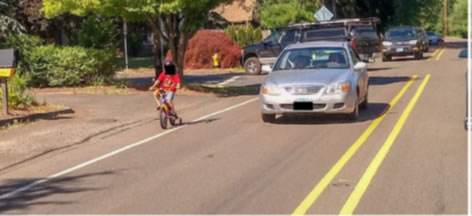« Previous
6. Case Study
TUF - Jackson School Road Project
- City of Hillsboro, OR. Medium size community. The use of the CIP ensures the adequate combination of funds from various sources in time and quantity over entire life of the project.
- Jackson School Road Project includes:
- Sidewalks
- Cycle tracks
- Continuous center turn lane
- Street lighting
- Culvert replacement
- Landscaped planter strips
- Landscaped planter strips
- The estimated cost is approximately $28 million. TUFs and Impact Fees provide almost $18 million and traditional sources around $11 million.

Source: City of Hillsboro Twitter
Opportunities
- Additional funding to meet road maintenance needs.
- In 2020, revenues generated by the TUF represent approximately 60 percent of the City of Hillsboro street maintenance budget
Challenges
- Legal challenges: Principles to establish TUFs not specifically defined by the State of Oregon. Ad Hoc Transportation Finance Advisory Committee.
- Political and public resistance: Inequities about how TUF rates are calculated and opposition from schools and non-profit organizations to pay. Waivers, credits, and incentives. Public education and outreach program.
- Equity challenges: Fairness at the time the TUF rate need to be revised. Appointment of an oversight committee.
- Lack of flexibility of funds: Funds generated by TUFs can only be used for road maintenance projects.
SA - Dulles Corridor Metrorail Project
- Fairfax County, VA. Big size community. Fairfax County uses the CIP as a planning tool coordinate the financing and timing of the Dulles Corridor Metrorail Project in a way that maximizes the return to the public.
- The Dulles Metrorail Corridor Project, also known as the Silver Line, is a 23-mile extension of the Washington, DC, region’s Metro system.
- The estimated cost is approximately $5,684 million. Fairfax County will pay$730 million using funds generated by two Transportation Improvement Districts (TIDs).

Source: https://www.dullesmetro.com
Opportunities
- The TIDs generate consistent revenue streams that can be used as funding or financing mechanisms.
- Fairfax County has been using funds generated by the two TIDs on a pay-as-you-go basis and to issue bonds.
Challenges
- Implementation challenges: Landowners and developers may see it as a new tax and disagree with district limits. Landowners Economic Alliance for the Dulles Extension of Rail (LEADER).
- Revenue stream challenges: Future revenues are uncertain. CIP and Districts Commissions annual reports.
- Lack of transparency and equity: TIDs can be perceived as hidden invisible local governments imposing unfair taxes. Public meetings of Districts Commissions and the Board of Supervisors.
IF - Baseline and Loop 202 Intersection Project
- City of Phoenix, AZ. Big size community. The city uses the CIP as fiscal planning tool to keep its budget balanced as mandated by the State of Arizona.
- The Loop 202 was recently completed after many decades of planning, public debate, legal action, and then funding issues. The Loop 202 connects with several major arterial streets, and one of those is Baseline Road. A new intersection is needed.
- The estimated cost of the Baseline and Loop 202 Intersection Project is approximately $3.3 million, and the city contributed approximately $1.6 million from street impact fees.
- The adjacent landowners provided the required public right of way to be dedicated for the roadway improvements.
Opportunities
- Bring the opportunity of having a new funding source, collected upfront, for transportation projects.
- Encourage developers to start the projects as soon as they are ready expediting the pace of development.
Challenges
- Implementation challenges: Significant amount of resources and coordination across city departments to fulfill the obligations mandated by the State of Arizona.
- Revenue stream challenges: Future revenues are uncertain. The City of Phoenix performs forecasts on impact fee revenue potential for the next 5 years.
- Resistance from developers and landowners: They may see equity issues because impact fees are higher in the north of the city. The City of Phoenix created the Committee of Development of obtain inputs from developers and landowners while informing them.
TRZ - Eastlake Boulevard Extension Phase 2
- Town of Horizon City, TX. Small size community. The city uses the CIP as fiscal planning tool to ensure that project funds are available when needed, develop interagency partnerships, and leverage other financing mechanisms.
- The Eastlake Boulevards Extension Project was critical for the Town, as it significantly improved the Town’s access to I-10 and connectivity to the City of El Paso, as well as to its neighboring City of Socorro.
- The project consisted of building a new six lane roadway, the project cost was of $16.7 million. The Town of Horizon City was responsible for paying$3.8 million.
- The Town of Horizon City paid its portion using the Town of Horizon City Transportation Reinvestment Zone No. 2 as a financing mechanism.
Opportunities
- Effective cooperation among local government agencies to improve regional mobility and transportation infrastructure.
- Advancement of economic goals through transportation investments.
Challenges
- Internal challenges:
- Introducing new funding concept to policymakers. Continuous communication between policy makers and key municipal staff.
- Determining TRZ size. CIP managers and financial staff working together to determine TRZ size.
- External challenges:
- Coordinating with external partners. Designate a team to lead those discussions.
- ROW acquisition. Work with property owners as early as possible.
- Changes in Property Designation. Be prepared!
FHWA Contacts
Thay Bishop
Center for Innovative Finance Support
Thay.Bishop@dot.gov
Stefan Natzke
Office of Planning, Environment, & Realty
Stefan.Natzke@dot.gov
« Previous

